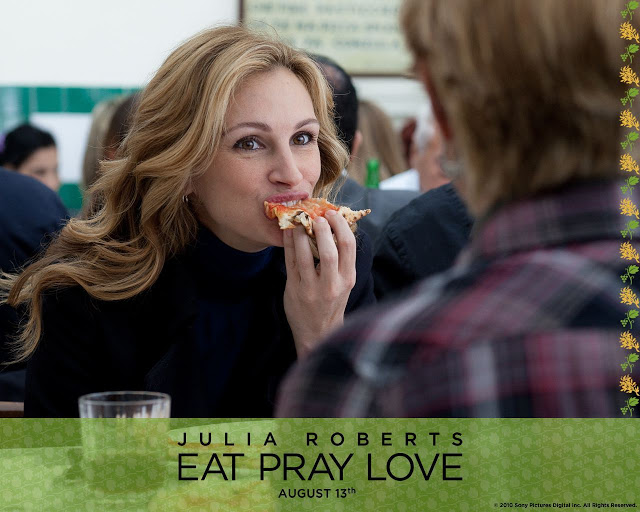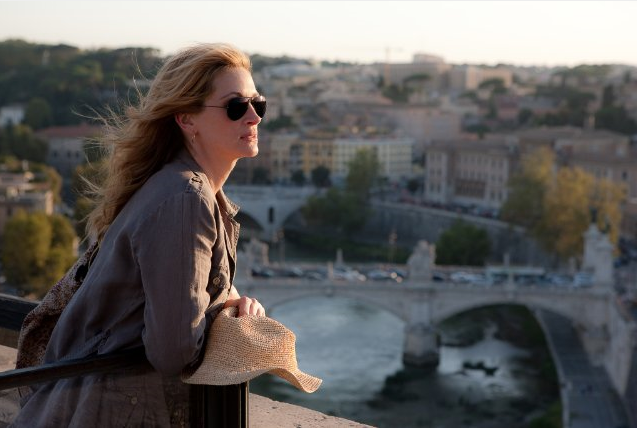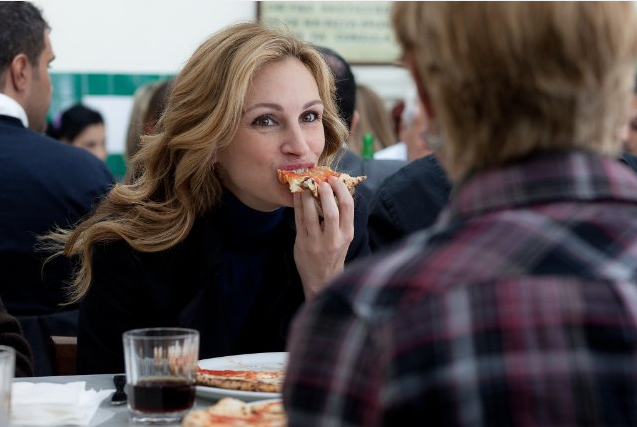 |
| Julia Roberts as Liz Gilbert in Eat Pray Love |
Guest post written by Jessica Habalou, excerpts from her unpublished Master’s thesis. Reprinted with permission.
“Every word in Italian is like a truffle:” Eat Pray Love and Food for Pleasure
Based on the extremely popular memoir of the same name,
Eat Pray Love is the story of Liz Gilbert, who embarks on a year-long stint abroad to help her recover from a bitter divorce and torrid love affair. Her marital malaise is a prime example of the Friedan’s “problem with no name;” she knows that having a big house and being a good wife and one day mother is not enough to satisfy her, and in fact render her desperately unhappy. So she leaves her husband and tried to discover what will bring her satisfaction. Initially, and under the influence of her new lover, Liz turns to religion to help ground herself. She devotes newfound time and energy to meditation, ruminating on God and studying the teachings of an Indian guru. But her holy immersion is misguided, for as Liz’s friend notes: “[Do] you remember a couple years ago when you threw yourself into the renovation of your kitchen? You were completely consumed with being the perfect wife and cook? Well, I think chanting and meditation are the same thing in a different costume.” Tapping into her innate wander-lust, Liz decides to travel to Italy, India and Bali. She announces in her friend’s office the full extent of her unhappiness: “I used to have this appetite for food, for my life, and it’s just gone. I wanna go someplace where I can marvel at something. Language, gelato, spaghetti, something. I have not given myself two weeks of a breather to just deal with, you know, myself.”
 |
| Eat Pray Love |
In Italy, Liz treats herself with complete abandon to the gastronomic pleasure therein, and in so doing, makes strides in her attempt at personal growth. Food and eating come to replace some of her vices and offer her the comfort of friendship and self-preservation. The visualization of food and the act of eating in the film go to great lengths that they are her supplement to sex. Through close shots of her eyes rolling back in delight as she takes her first bite of a Napoleon, extreme close-ups of her lips wrapped around a forkful of pasta, or detailed shots of her cutlery probing into a plate of fried prawns to release a mini-explosion of juices, there is little subtlety applied to the sensual and erotic role of food. In one scene, Liz is at an outdoor cafe, and the camera cuts between a young couple kissing and fondling each other and Liz at her table, watching them, then her plate of spaghetti appear. The camera continues to shift between the couple and Liz advancing on her plate, grinning with each bite. When the plate is cleaned and the couple is gone, Liz smiles deeply as if she has a secret – the act is finished. Visually, food is heavily sensualized, in a way rivals and often surpasses the sensual display of food on the Food Network. While this is likely do in part to the film appealing to the Food Network demographic, and therefore complying with a certain expected visual aesthetic, the eroticization of food in Liz’s Italy also helps to emphasize that she is single, celibate, and finally experiencing pleasure outside of romance.
The sensual connection to Italian food and Italian language is another important component of Liz’s experience in Italy. Before her departure, she declares to her friend after studying an Italian dictionary that “every word in Italian is like a truffle.” She finds and becomes friendly with an Italian language tutor, with whom she is often seen at a cafe, eating and drinking. In one scene, the two are at an outdoor cafe (a common motif), eating and sipping red wine. At this point, her tutor introduces her to an idiom meaning “to cross over:” “attraversiamo.” Student and teacher repeat the word several times, and each time to camera zooms tight on the lips of the speaker, similarly to how Liz is shown eating on camera. The word itself, then, and the language, are like food in the sense that they fulfill her physical, emotional and sensual desires.
 |
| Eat Pray Love |
What is unique about Liz and her relationship with food is that for her, it is not a mere comfort, means of escape, or potential nemesis. Food and the pleasures of eating bring Liz closer to herself, and to other people. Given the frequency with which she dines with companions in Italy, it is difficult to believe that Liz would feel utterly despondent and isolated. The only moment in which she seems to regress to her emotionally fragile, post-breakup self is when she is alone in her apartment, once again pursuing her Italian dictionary, and repeating to herself: “io sono sola,” or, “I am alone” (in this moment, the camerawork shows the dictionary’s words from Liz’s vantage point, blurred as if seen through tears). But all told, she enables her own self-worth through food, and that of her friend’s as well. All the talk about eating and indulging is not without commentary about the effects it has on the figures of the women doing most of the indulging, Liz and her friend, Sofi. In a scene depicting a day trip to Naples, Liz and Sofi are seated across from each other at a crowded, chaotic pizza shop. Per usual, Liz takes a bite and rolls her eyes in pleasure, saying “I am having a relationship with my pizza.” Seeing Sofi with her hands in her lap, she says “You look like you’re breaking up with your pizza. What’s the matter?” “I’ve gained, like, ten pounds,” she says, her eyes shifting guiltily. Rather than trying to amend the situation by offering to start dieting or visiting the gym with her tomorrow, Liz says: “I’m sick and tired of saying no and waking up in the morning and recalling every single thing I ate the day before . . .so I know how much self-loathing to take into the shower. I’m going for it . . . I’m just through with the guilt.” Sofi smiles and eats. Afterward, the scene cuts back and forth between split shots of the women at a crowded bar watching the soccer and in a dressing room attempting to button multiple pairs of jeans. The scene culminates in a Lucille Ball-style moment of comedic excess, with an aerial shot of Liz on the floor of the dressing room, Sofi hovering over her and successfully snapping the button into place, and the image of men at a bar cheering at the soccer game while Liz and Sofi applaud their own “victory.”
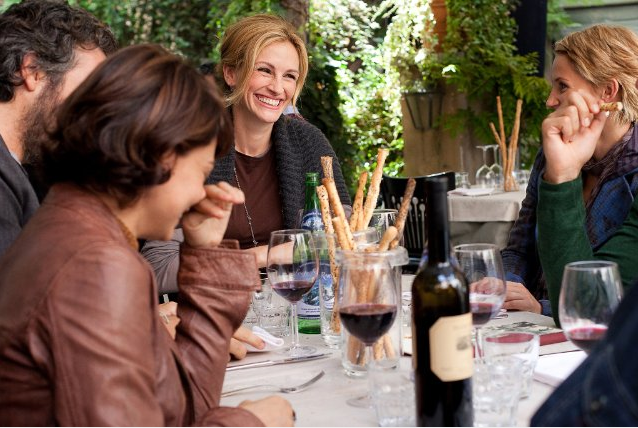 |
| Eat Pray Love |
Liz’s chapter in Rome concludes with a Thanksgiving celebration with her Italian community of friends. The scene is shot in the cozy quarters of her Italian tutor’s mother’s house, somewhere recessed from the hubbub of the city. It is evening, and the group is preparing vegetables, talking and laughing, when they discover that the turkey is not thawed to roast. In the same “devil-may-care” attitude of which Liz has become so fond, they eat the rest of the meal and save the turkey for later. Around the table, Liz instructs her friends on the American Thanksgiving custom of announcing one’s gratitude. “This,” says Liz, gesturing to the table, “all makes me feel so grateful.” The next shot depicts the friends strewn across the living room, sleeping with heads on laps, across couches and chairs and the floor. Early morning light creeps in the windows, revealing bottles of wine and half-finished plates about. The scene is tranquil. An alarm rings, and Liz wakes to remove the turkey from the oven. The group gathers again around the table for the breakfast bird, and Liz arrives as if out of the Rockwell painting, holding an archetypically dressed bird on a platter. Through her divorce (and severance from marital and familial obligations), she has found all the normative, American comforts of home and family.
“What is it you really like to do?” Julie & Julia and Domestic Ambition
 |
| Amy Adams as Julie Powell in Julie & Julia |
Julie & Julia, directed by Nora Ephron, is based on two textual, real-life accounts: Julie Powell’s weblog project where she spent a year cooking ever recipe in Julia Child’s seminal Mastering the Art of French Cooking, and Julie Child’s My Life in France, co-authored and published posthumously by her nephew Alex Prudhomme. The film garnered popular and critical acclaim, particularly for Meryl Streep’s performance as Julia Child, for which she was nominated for an Academy Award. Since Julia Child’s life was so publicly oriented around food, one might expect the “Julia” portion of the film to be as well. On the contrary, food is a secondary function to Julia’s relationship to her husband and professional ambition, particularly when compared to the Julie narrative. No doubt that Julia’s love for food is a driving force in the film – when musing with her husband Paul in a Paris restaurant over how to fulfill her personal void, Paul asks “what is it you really like to do?” “Eat,” she replies, with gusto. Julia’s seemingly charmed life – replete with a loving husband, a girlish exuberance, and a steadfast resolve in the face of setbacks – is surrounded by food. The viewer sees that Julia’s time in Paris is played against the background of crowded outdoor markets brimming with bright, fresh produce and pigs’ heads. She stops at street vendors for chestnuts, hosts dinner parties with friends, and doggedly chops, flips, dices, and whisks her way through her education at the esteemed and deeply traditional Le Cordon Bleu. She is seen offering Paul a plate at lunchtime before he whisks her off to the bedroom. But more important than the food in these sequences is her relationships with the characters – she charms the vendors, listens to her instructor, plays a proper hostess while images of plates and the sounds of clicking silverware occupy the backdrop, and a good wife who both offers food to her husband and forgoes it in the interest of satisfying their sexual desires. In this sense Julia is a free spirit, a professional, a lady, and a lover. She is motivated by food, but not controlled by it.
 |
| Meryl Streep as Julia Child in Julie & Julia |
While food supplements Julia’s already rich life experience, it seems to define Julie’s. Food serves to enrich a visual backdrop in Julia’s world, it is a primary focus in Julie’s. Julia’s time in the kitchen cooking her way through Mastering the Art is visually expressed through multiple tight, close-up shots of the ingredients she is prepping, the food in various stages of cooking, and the finished product. These are much like the shots viewers are accustomed to seeing on the Food Network, with food shown in stages of preparation: butter sizzles in the pan, mushrooms turn in the butter, cream and port gush into the works, chicken browns in the fat, all to the soundtrack of sizzling and cracking. In fact, Susan Spungen, former art director or Martha Stewart Living magazine directed the food styling in both Julie and Julia and Eat Pray Love (Kingston 2010). In these tight, close shots, food is the focus, and occasionally the hand that cooks it. The viewer becomes completely engaged in the cooking, much like Julie is completely immersed in her project.
Julie’s obsession renders her more flawed than Julia’s character, even to the point of being unlikable. As Benson-Allott suggests, “[b]ecause Child is an idealization…Powell seems deeply flawed in contrast.” She concedes that “Adams makes a bold choice to allow her character at times to become quite annoying” (85). She bumbles her way through her marriage as she becomes selfishly consumed by the popularity of her blog. The couple fights over her selfishness, prompting him to storm off in a rage. In a separate incident, her husband diagnoses their marital problems as being symptomatic of “too much food, not enough sex,” as if to suggest that she is neglecting her conjugal and marital obligations in the interest of pursuing her own gain.
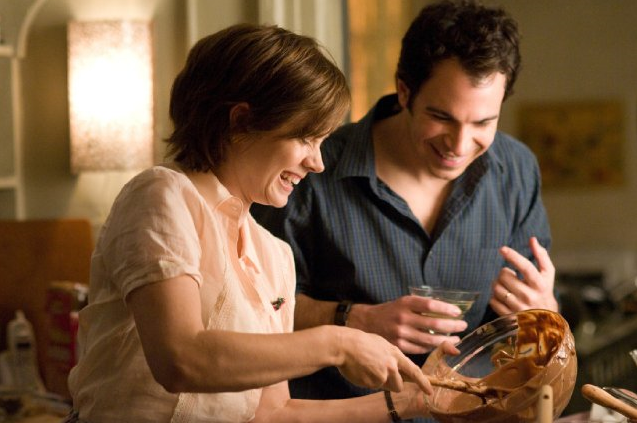 |
| Julie Powell (Amy Adams) and Eric Powell (Chris Messina) in Julie & Julia |
Julie’s obsessive relationship with food manifests itself not only through her marriage, but physically as well. In one scene, Julie goes on a spending spree at the gourmet goods store Dean and Deluca. She wedges herself and her parcels through a turnstile, then lugs her bags and parcels with her down the subway stairs, bangs into exasperated commuters and runs to catch a train while her voiceover explains “[I was] sweating like a pig, which is not surprising because I’ve been way too busy cooking fattening foods to bother exercising.” This claustrophobic environment reveals some of the ill effects of her personal and gustatory indulgences. The frustrated looks on commuters’ faces while she tries to navigate her way through rush hour while bearing the load of consumerism both on and in her body is like society’s judgmental gaze at a women’s overindulgence. Like the characters of Sex and the City and post-9/11 New York-based chick flicks that Negra analyzes, Julie is navigating through the anxious, often dissatisfying climate of “cultural dilemmas and stigmas.”
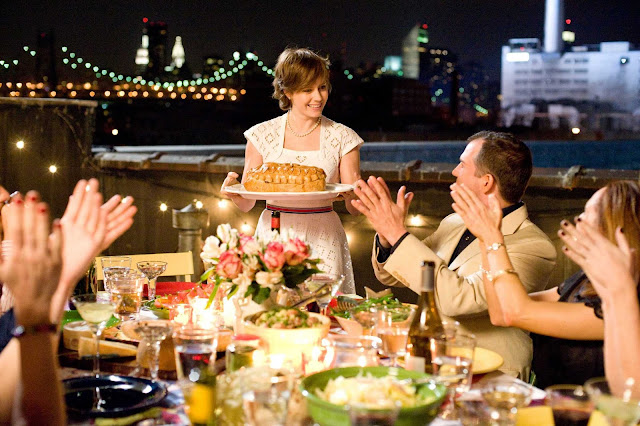 |
| Julie & Julia |
Julie’s high points are reflected in the success and visual quality of the food she produces – and vice versa. When she initially hatches her blogging idea, she is making bruschetta. Hunks of bread sizzle and brown, and she chops impossibly red tomatoes and verdant basil leaves. The combined dish is a food stylist’s masterpiece, as if to verify that Julie not only has the chops to take on her idea, but that only good, delicious things will come as a result. Things are looking up when she learns that Knopf’s powerhouse Judith Jones will be dinning at her house; in preparation, Julie prepares boeuf bourguignon, a dish whose rustic charm is deliberately revealed in a close shot, exposing the parsley-flecked stew’s deep, earthy tones, enrobed by a Le Creuset pot. The shot radiates authenticity and perfection. Of course, as evidenced above, Julie’s ambition is not without its flaws. Her short-tempered in the kitchen coincide with some of the ugliest food in the film: aspics. As the brown, gelatinous mess slips off the plate and into sink, she rails against the inadequacies of the kitchen space in her apartment. And after a raw chicken stuffed with liver and cream cheese hits the floor with a sickening splatter, she splays out on her back on the tile, kicking her feet and weeping like a petulant child. Despite her blog despite her self-conscious weight gain, her strained marriage, her overwrought schedule, her tenuous start, she continues to blog. Interestingly, she maintains a generally ambivalent attitude toward eating itself. Her husband, her friends, and her guests are the ones who seem to enjoy the fruits of her labor. For Julie, the satisfaction is in the effort, and the perceived control. “I love the after a day when nothing is sure and when I say nothing I mean nothing you can come home and absolutely know that if you add egg yolks to chocolate and sugar and milk it will get thick. It’s such a comfort.” The pleasure for Julie is not in consuming, but in producing. The act of production is what fulfills her, and for it she sacrifices conventional domestic obligations.
Works Cited
Benson-Allott, Caetlin. “Mastering the Art of Feminist Mentorship.” Gastronomica: A Journal of Food and Culture. Spring 2010: pp. 83-85. Print.
Negra, Diane. “Quality Postfeminism? Sex and the Single Girl on HBO.” Genders Journal. Issue 39, 2004. Web. Google Scholar.
———-
Jessica Habalou works with food and wine at Boston University, and is a degree candidate for BU’s Master of Liberal Arts in Gastronomy. Her research interests include food, feminism, and popular culture, which involves lots of eating, drinking, and watching movies.




